
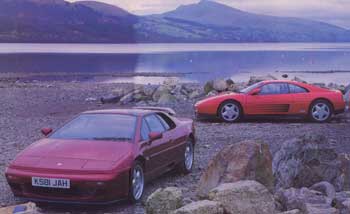
The shapes may be
familiar, but the cars have changed. And there are more than a
few surprises.
Richard Brenmer assesses two cars that leave him
bothered and bewildered as well as...
Bewitched
FERRARI 348 tb v LOTUS ESPRIT S4
CAR Magazine, April 1993
Photographs by Richard Newton
You're buying two things when you acquire cars like these – style and sensation. Many buy them hoping the first quality will rub off on them. Hoping , too, that the second will be generated wherever they go. That may be the point for some, but for others, it's the tactile charge they deliver once they're on the go; and when stopped, the pleasure they give simply as automotive art.
Well, there's no doubt that Ferrari's 348 has bags of style. It may be more than three years old, but we haven't heard anyone saying that it's beginning to date, or that, on reflection, it isn't such a worthy follow-up to the exquisitely styled 328.
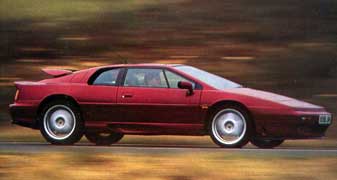
The Esprit is barely less striking, though it doesn't have the Pininfarina clarity of line, and that new opening in the front spoiler, intended to echo the air intake shapes of Lotuses past, doesn't quite suit its lines. But it's certainly not short on drama and impact. That's true of the drive as well. Trickle along in second at 1200rpm, and floor the throttle. Your initial rate of advance will barely challenge a shopping car, but once the crank strikes 3000rpm the Esprit bounds forward with startling vigour, crushing any doubts you may have harboured of the efficacy of a mere four cylinders, 2.2 litres and a turbocharger to deliver superleague performance. True, this motivator doesn't sound so wonderful, but we'll get to that when we make some other rather diverting discoveries.
Unexpected discoveries became a feature of our time with the 348, too. A curious kind of refinement was one of them. You would not call that quad-cam V8 an unobtrusive piece of machinery, and yet somehow, it conspires to deceive you into thinking you're going slower than you really are, a not entirely desirable characteristic in the Gatso age.
Last time we compared this duo (CAR, October 1990) they were part of a four-car showdown, one in which the Ferrari came first, closely tailed by the Honda NSX and Porsche 911 Carrera 2. Lagging badly was the Esprit Turbo SE, which was comprehensively outpointed by the rival trio. Since then, both the Lotus and Ferrari have moved on – the latter being subtly but significantly altered beneath the skin, the Esprit evolving into its fourth major iteration, the changes embracing its look, practicality, and chassis behaviour.
That the Lotus needed work in the last two areas is unquestionable, the stunning performance of that blown 2.2 SE engine never matching the abilities of the chassis, a failing that served only to emphasise the car's deficiencies in other departments. In short, it embodied frustration on wheels. And Lotus needs this car to work, because, it is its only remaining model, the Elan having been very publicly and prematurely interred just months after the old Excel turned axles up. If no-one wants the Esprit, then the unmentionable must be mentioned – Lotus will crease to be a car maker.
Ferrari faces no such threat, though it has had to cut back production lately. It has also been busy quietly improving the 348 (which will shortly go on sale in convertible guise). It was a car, it seems, that wasn't quite all it could have been to those who bought them. Complaints of tricky handling had been made – we levelled them ourselves– as well as an over-firm ride, and there have been attempts to fix both. Along the way, there have been minor changes in other areas, too, not the least being a reduction in weight, astonishing when you consider that cars almost invariably get fatter as they grow older.
So, down to specifics. The 348 chassis has had a number of modifications since birth, including a change to softer springs and firmer dampers all round to improve the ride. More significant, however, is the repositioning of the rear upper wishbones, a geometry alteration designed to keep more of the back tyres' contact patch in touch with the tarmac. The steering gear and front suspension geometry remain unchanged, as do the tyres, our car arriving on Pirelli P700Z 215/50 ZR17s up front, 255/45 ZR17s at the rear.
The 3.4-litre V8 is essentially unchanged, but now wears a catalyst, an addition prompting Ferrari to lower the gearing by four percent to counter the loss of a few horsepower, the stable now housing 295. Weight saving has shorn around 70lb from the 348's bulk, mostly by changing component specification – several pounds have been lost by changing the European starter motor for a more compact Japanese item, for instance. The gear linkage is now slicker, and the transmission's oil viscosity rating has been altered to the same end.
There have been detail changes, too – less resistant door releases, and replacement of the original cheapskate oil and petrol filler caps with beautiful aluminium items.
The Lotus has seen considerably more change than this, as well it might given its deficiencies and age, this facelift taking it, amazingly, into its 18th year. Let's deal with the looks first. The essence of Peter Stevens' excellent facelift of the Giugiaro original remains, but the gruesome, over-size wing planted on a year ago has been replaced by a considerably more modest, if unmissable, item that also supplants the glass panel that lay aft of the cabin's rear window.
Paring off bulk, rather than adding it, has been the theme of exterior re-sculpting that sees new front and rear bumpers, reshaped sill extensions, a modified bonnet, new door skins, revised air scoops and, miracle of miracles, the deletion of those old Morris Marina door handles in favour of the flush Rover 200 variety. There are also new, slimmer front indicator/sidelight units and a different tailpipe finisher. Not radical, but enough to entertain the spotters.
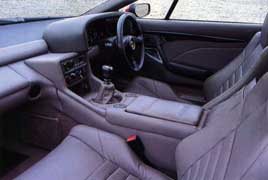
Anyone familiar with Esprits will immediately sense that there have also been alterations inside, not least because it's much easier to climb aboard now, though it's still hard to stop an errant right foot from scuffing the handbrake and fascia. But the doors open wider, and their trims are attractively restyled, gaining a veneer of modernity from clever use of decorative carbon fibre.
The same material is used to house the relocated instruments and face-level vents, and there are new stalk controls, as are the interior door handles. The steering wheel is new as well, a heavily sculpted Nardi item. It's now connected to a power-assisted rack, a first for the Esprit and a development that has allowed a rethink of the front suspension geometry that in turn has been complemented by a new anti-roll bar, springs and dampers. The front spring towers have been reinforced, too. There are also revised coils and shock absorbers at the rear, a fresh set of five-spoke 17in alloys that sit on Goodyear Eagle GS-A rubber of 215/40 section up front, and 245/45 at the rear. Lotus took two years integrating the assisted steering system into the Esprit's make-up hoping to minimise the loss of steering feel, and maximise the handling benefits.
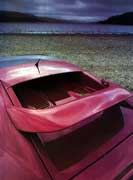
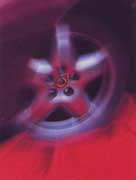
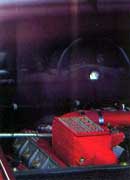
The Lotus's hyper-hyper powertrain has also seen some attention, all the engine's castings have been upgraded for stiffness and additional cooling capacity, while the head gasket is now of sterner stuff and the engine management chip has been reworked to command more torque at lower revs. The engine's spectacular 264bhp output remains unaltered, however. The gearbox has been beefed up a bit, and the shift action honed for greater precision.
So, a not insignificant rework. You're not unaware of the fact, either, when you clamber aboard the car to face that carbon fibre-clad instrument pod. Although the basic architecture of the cabin is unchanged – so you sit low, your view slightly impeded by the instrument pack – there's plenty of fresh detail, most of it contriving to rid the car of its bitsa feel, even if it carries much of the same quantity of borrowed hardware as before. Twist the key and familiarity floods the ears as the gruff old four fires up and chunters unenthusiastically behind you. This is not the sound of a supercar – more something marine, that hauls nets about.
Still, the Esprit feels suitably fleet once under way. In fact, it takes you mere yards to tumble one of the car's big improvements – it's steering feels wonderfully direct, its chassis alert to your orders. Nor does it take much effort to manoeuvre the car now that the steering and gearchange efforts have been reduced. Your biggest challenge is seeing out.
Seeing out of the Ferrari, on the other hand, is as easy as could be hoped for in a mid-engined car. It's worth swivelling your head because you will actually see scenery over your should rather than opaque bodywork. The view ahead is good, too, better than in the Lotus, because the dash dominates less and you sit slightly higher.
The V8 fires cleanly and sounds busy at idle, like Ferrari motors always seem to. The most dominant sound is a not terribly pleasant whine, rather than the low wufflings that V8s usually make. The clutch is heavy – noticeably weightier than the Esprit's – and the gearchange is more resistant still, modifications or not. Entering first, out on a dog-leg, requires quite a heave, and moving to second considerable thrust, especially when the car is cold. Still, that's an improvement because before, second gear was out of bounds until the gearbox oil had warmed.
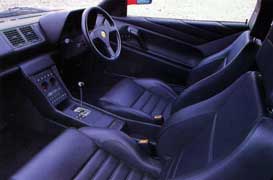
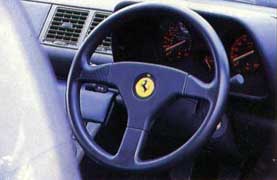
Transmission trouble apart, the 348 is a relatively easy drive. It pulls smoothly and the driveline doesn't jerk once you're used to a throttle that seems inappropriately light and sensitive compared with the clutch action. And if the pedals are offset towards the car's centre line, well, that doesn't seem to matter. The steering, being unassisted, demands energy in manoeuvres but lightens up very quickly, not least because it is lower-geared than the Lotus's. The Ferrari feels less eager to change course because of this and at lower speeds, doesn't dart into turns with the zeal of the British car.
Indeed, the Lotus changes direction with just the sort of aplomb you'd hope for, and ought to get, in return for suffering the inconvenience of a space-wasting mid-engine layout. Initially, you'll probably have trouble guiding the car smoothly because you'll be turning the wheel too far, steering with your arms rather than your wrists. Once you're used to this sensitivity, though – and responsiveness like this seems so are in modern cars now – you'll enjoy the fluency of progress that can be achieved for such economy of movement.
Not that the Ferrari has to be heaved about, and in any case, once it's travelling briskly, the steering becomes more reactive and needs less effort. It's also keen to relay details of the topography flowing below. Which is great, except that the car's directional stability isn't quite in the high-speed train class. If the road camber falls away, then you'll know it, and while you don't need to clench the rim in earnest, you do need to firmish grip.
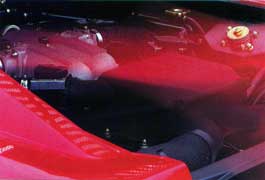
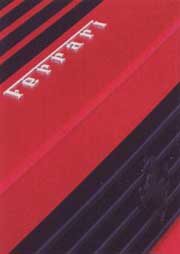
You'll have no trouble working out what's happening up front then. But behind, it's a different story. Take an energetic drive in a rapid mid-engined car, and what you need to know more than almost anything else is how close to the handling edge you are. Feeling those fat rear tyres move and sensing when the car's purchase might be challenged is hugely important, because you're going to be travelling fast, and if an adjustment has to be made, then it must be made fast. Mid-engined cars, once they let go, can pirouette faster than Torvill and Dean. The bad news is that the Ferrari doesn't telegraph enough information early enough.
Say you're hurtling along a gently winding road, a smooth open one that allows you to make much of the fact that third gear will take you to a screaming, hammering and exhilarating 100mph. Well, I can tell you that on the wet Welsh roads that we were on, cornering at anywhere near that speed felt a tad too uncomfortable for enjoyment. The car never had a real slide, but there's a point where the rear end twitches, and that has you wondering. Are the tyres merely settling into the turn, digging in for reassurance? Or are we about to witness a tail slide aboard a rapidly moving car whose weight lies resolutely at the wrong end, a car that will bite itself, and you, more quickly than a rabid dog? Well, we never found out how nasty the bite would be, I'm happy to say, but we did push a little harder to find out what happens once that settling motion has passed. As you might hope, the car adopts a more neutral attitude. But you still can't feel enough – less, indeed, than we did in the 348 we tried in 1990 – and that is inhibiting. So, what you have here is a challenge.
The same is true of the Lotus, though it's one you'll take to more readily because you learn more about where the challenge lies. This car speaks where the Ferrari is mute. No, it's steering doesn't chatter as much s the 348's (though it's informative enough) but your frame learns so much more through your seat. Keenly taken turns will always see the Esprit rolling more than the 348 – itself a guide to the cornering forces you're building – but more than that, you can sense what the tyres, particularly those behind you, are up too. Quite simply, you have a better idea of where the limit lies. Combine this with that super-quick steering and a reasonably pliant ride, and you have a car that you can feel like it's going to spin or surprise you with a slide. And that means you can push it harder, easily deepen your knowledge of what it can do, and drive it better.
That said, driving the Lotus cleanly isn't easy, because there are two serious flaws working against that fine chassis. First is the pedals, which are so tight-packed that pressing brake and accelerator simultaneously is a regular event. The broad of foot will probably have difficulty driving it all with any finesse. Then there's driveline shunt, the powertrain regularly recording sevens on the Richter scale as it jerks about. Supreme delicacy is required if you're to avoid it, and the problem here is that you often need to be quick with throttle to stroke the blower for a rapid exit from a corner, or a swift piece of overtaking. Both are serious faults, one highly irritating, the other potentially dangerous. Concentration will overcome both difficulties, but really, you should be free to direct your efforts to other aspects of the Lotus experience.
It's a bit like that in the Ferrari, but for another reason, because the gearchange really is absurdly resistant. If this obstructiveness is supposed to be part of the Ferrari tradition, then damn tradition – if this car had a gearchange as slick and positive as a Toyota MR2's, then getting the best out of it would be far more enjoyable.
The Ferrari is better sorted in other areas, though. It rides pretty well, and what stiffness there is can be forgiven when the car feels as taut and robust as anything the Germans make. The important switchgear is easy to target (not true of the ludicrously complicated climate controls), the instruments read easily, the brake pedal is well weighted and potent, the wipers effective and, like we said, visibility is good, which is very important in fast cars. The seats are fairly comfortable, but the driving position is a little long-arm, short leg, and the wheel, despite being adjustable, can still obstruct a heeling-and-toeing right leg.
But, for long journeys, the 348 is a relatively comfortable mount. What will wear you out, eventually, is the noise. Not of tyres, or rushing air, but of that V8, which whines and drones rather too keenly at a cruise. It might sound glorious close to the danger paint, but the truth is, a Rover V8 fettled by TVR sounds better than this.
The Ferrari sounds a hell of a lot better than the Lotus, though. Those four pots mimic a chain saw at high revs. It's the whine, presumably of belt drives, that's most insistent, mostly drowning the gruff note of the combustion process itself. Still, the engine is smooth and, above all, madly powerful. As with every turbo there's an element of delay in its behaviour, but the pause is brief and can usually be driven around by the simple expedient of pressing the right pedal earlier than seems natural. And the rewards are great. Rain stopped play when we took this pair testing (the claims for the Lotus are 4.7sec to 60mph and 165mph) but we did record in-gear go, in fourth, the Esprit will sprint from 50 to 80mph in 6.4sec, a blistering display that makes it easy to understand how it can cover ground so fast. There's more than enough effort here to entertain in itself, without indulging other joys.
It's the same with the Ferrari. Getting at its go is much simpler than in the Lotus because the engine is hair-trigger responsive, and there's plenty of it. It doesn't have the momentarily dizzying acceleration of the Esprit coming on boost, but its more linear delivery is more useful, especially through twisty turns. Ferrari claims 5.6sec to 62mph and a 169mph top speed while the fourth-gear lunge from 50 to 80mph that we could measure too 7.9sec. Despite the sometimes over-bearing noise, there's something very cultured in the Maranello V8's manner of delivery. It's so fussless and it's so easy to go so quickly.
This is not likely in the Lotus. Aside from the gruff business of its motor, there's wind noise from the sunroof, the roar of tyres and the occasional rattle and squeak (they will doubtless breed with time) to add to an off-key symphony. It's not deafening or anything near it, but the Lotus is not quiet. Nor is it as finished as it ought to be after so long. The single wiper is utterly pathetic, the instruments are too small and hard to read, the air-conditioning controls near unfathomable without the handbook (absent from our car), and the handbrake remains a foot too far away. More seriously, the brakes, though very effective, don't feel like they're going to be and the gearchange, while vastly less demanding than the Ferrari's, could be slicker between fourth and fifth. And, with that glass sunroof, we can't believe that the Esprit isn't hell on a hot summer day.
Yet it is the better driver's car. It offers a more tactile experience than the Ferrari where it counts – in the chassis department. There's a more fluent exchange between car and driver, and for that reason, more enjoyment to be had from it. It also goes like a startled rabbit. The Ferrari has a longer list of draws and a shorter tally of flaws, but than uncertainty we felt over the chassis puts it behind the Lotus. Dynamics, performance and style are the most important elements of cars such as these, and the 348 falls slightly short. That's quite a surprise, given the attempts Maranello has make to improve it.
And yet... I know it's irrational, but if I had more money than sense (not hard, actually, so let's say considerably more) and was unworried by the fact that the prices of the Lotus and Ferrari run the same digits in a different order (£47,000 versus £74,000) then I would still buy the 348. Why? Because of the name, the history, the exquisite styling, the robustness, the sheer excitement of it, even if there's a bit too much of that when you venture close to the edge.
If the Lotus were that bit more refined, had a less jerky, more euphonious driveline (and that means adding cylinders), less alarmingly arranged pedals, and quality that didn't feel like it was from the cheaper end of the street, I might be swayed. That's if money doesn't count. It usually does, of course, and that makes the Lotus a more serious proposition. The great news is that this old, old car competes again, is once more desirable. It looks like a supercar, it goes like a supercar and it handles like on. It is a supercar. But a Ferrari, even a flawed Ferrari is just too bewitching. It is the supercar.
|
|